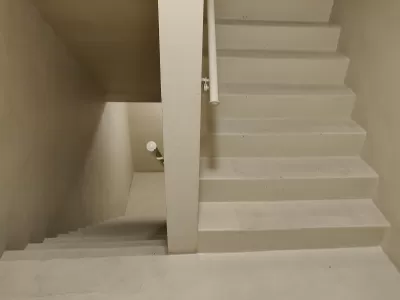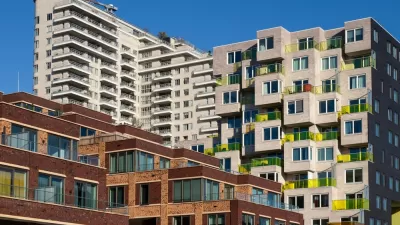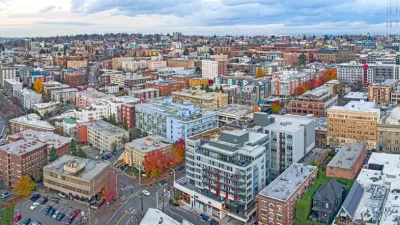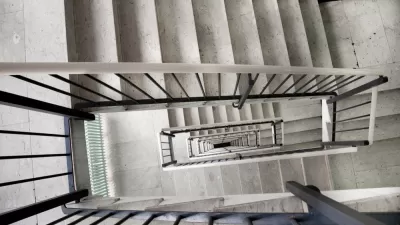U.S. building codes mandate two staircases in multi-story buildings, but some argue this requirement reduces affordability and encourages wasteful, uninspired design.

A group of architects and developers led by architect Michael Eliason is arguing against building codes that mandate more than one staircase in apartment buildings, saying that the requirement "produces smaller, more unpleasant, more expensive apartments in larger buildings full of wasted space. As Henry Grabar notes in an article for Slate, "Most American apartment buildings over four stories are required to include two means of egress from every apartment" for fire safety purposes. But Eliason argues that buildings in other countries that permit one-staircase construction are no less safe from fire.
Eliason observes that when you require every apartment to connect to two staircases, you all but ensure those units are built around one long double-loaded corridor, to give all residents access to both stairways. You tilt the scales in favor of larger floor plates in bigger buildings, because developers need to find room for two stairways, and connect them—and then compensate for the unsellable interior space consumed by the corridor.
Single-staircase advocates argue that second staircases hinder affordability and construction of "missing middle housing," while building fires are much less common than when the rules were put in place. Currently, Seattle is the only U.S. city that permits single stairs in buildings as tall as six stories.
FULL STORY: The Single-Staircase Radicals Have a Good Point

Manufactured Crisis: Losing the Nation’s Largest Source of Unsubsidized Affordable Housing
Manufactured housing communities have long been an affordable housing option for millions of people living in the U.S., but that affordability is disappearing rapidly. How did we get here?

Americans May Be Stuck — But Why?
Americans are moving a lot less than they once did, and that is a problem. While Yoni Applebaum, in his highly-publicized article Stuck, gets the reasons badly wrong, it's still important to ask: why are we moving so much less than before?

Using Old Oil and Gas Wells for Green Energy Storage
Penn State researchers have found that repurposing abandoned oil and gas wells for geothermal-assisted compressed-air energy storage can boost efficiency, reduce environmental risks, and support clean energy and job transitions.

Updating LA’s Tree Rules Could Bring More Shade to Underserved Neighborhoods
A new USC study finds that relaxing Los Angeles’ outdated tree planting guidelines could significantly expand urban tree canopy and reduce shade disparities in lower-income neighborhoods, though infrastructure investments are also needed.

California's Canal Solar Projects Aim to Conserve Resources and Expand Clean Energy
California’s Project Nexus has begun generating electricity from solar panels installed over irrigation canals, with researchers and state agencies exploring statewide expansion to conserve water and boost clean energy production.

HHS Staff Cuts Gut Energy Assistance Program
The full staff of a federal program that distributes heating and cooling assistance for low-income families was laid off, jeopardizing the program’s operations.
Urban Design for Planners 1: Software Tools
This six-course series explores essential urban design concepts using open source software and equips planners with the tools they need to participate fully in the urban design process.
Planning for Universal Design
Learn the tools for implementing Universal Design in planning regulations.
Heyer Gruel & Associates PA
City of Moreno Valley
Institute for Housing and Urban Development Studies (IHS)
City of Grandview
Harvard GSD Executive Education
Salt Lake City
NYU Wagner Graduate School of Public Service
City of Cambridge, Maryland





























